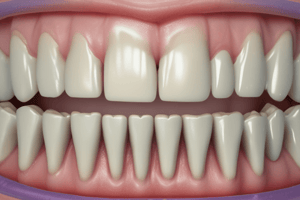Podcast
Questions and Answers
What is the vertical dimension at occlusion (VDO)?
What is the vertical dimension at occlusion (VDO)?
The vertical dimension at occlusion (VDO) is the vertical dimension where the teeth, or occlusal rims, are in contact.
How can the vertical dimension of rest (VDR) be measured?
How can the vertical dimension of rest (VDR) be measured?
To measure VDR, place a dot on the tip of the nose and chin, then have the patient lick their lips and close slowly until their lips barely touch.
What is a facebow transfer and why is it important?
What is a facebow transfer and why is it important?
A facebow transfer is used to relate the maxillary arch to the skull via a third reference point, ensuring accurate orientation of the maxillary cast on the articulator.
Describe the process to record centric relation.
Describe the process to record centric relation.
How can one evaluate the vertical dimension during denture fitting?
How can one evaluate the vertical dimension during denture fitting?
What is the objective of the occlusal plane?
What is the objective of the occlusal plane?
What does the vertical dimension at rest measure?
What does the vertical dimension at rest measure?
What is the purpose of a face-bow transfer?
What is the purpose of a face-bow transfer?
How is the occlusal plane established in relation to anatomical landmarks?
How is the occlusal plane established in relation to anatomical landmarks?
What are the key steps in marking the maxillary rim for teeth selection?
What are the key steps in marking the maxillary rim for teeth selection?
Flashcards are hidden until you start studying
Study Notes
Occlusal Plane and Vertical Dimension
- The occlusal plane determines the horizontal and vertical levels of teeth.
- Vertical dimension measures space between rims at rest and in occlusion.
- Centric relation records the most posterior position of the mandible to the maxilla.
- Freeway space is the interocclusal space, typically 2-4 mm (difference between VDR and VDO).
- Vertical dimension at rest (VDR) involves no teeth contact and relaxed muscles.
- Vertical dimension at occlusion (VDO) occurs when teeth occlude.
Face-Bow Transfer and Centric Relation
- Face-bow transfer records jaw position related to the mandible's opening axis.
- Centric relation is retrievable and essential for edentulous patients.
- Centric relation is recorded using wax rims at the vertical dimension of occlusion.
Marking Occlusion Rims and Establishing Occlusal Plane
- Maxillary rims should have approximate lengths: 22 mm anterior, 20 mm posterior, and width of 3-5 mm anteriorly and 6-10 mm posteriorly.
- Occlusal plane is an imaginary surface touching the incisal edges of anterior teeth and cusps of posterior teeth.
- Rims should align parallel to Camper's Line and the pupils of the eyes.
- Correct length of maxillary rim is dictated by the relaxed upper lip position.
Denture Creation Steps
- To evaluate vertical dimension, record VDR, observe patient at speech, and ensure comfortable closure.
- Beading the maxillary cast aids in transferring major connector designs and tissue contact.
- The swing-lock consists of a labial bar hinge-latched to the major connector for missing abutments.
Major Connectors and Their Applications
- Mandibular major connectors include lingual bar, lingual plate, sublingual bar, and labial bar.
- Indications for a lingual bar include adequate space and no inoperable tori or frena.
- Indications for a linguo-plate include close proximity of alveolar sulcus and future tooth replacements.
- Complete palatal plates are suited for situations with extensive missing anterior teeth or poor abutment support.
Blockout Techniques
- Blockout eliminates undesirable undercuts to aid in framework design.
- Shaped blockout is used to locate clasp arms; parallel blockout is for guiding planes.
- Relief is provided in areas where connectors contact thin tissues.
Use of Diagnostic Casts and Treatment Options
- Diagnostic casts supplement exams, provide surveys of dental arches, and offer references during treatment.
- Treatment options for short modification spaces (≤3 missing teeth) include natural tooth-supported fixed prostheses or removable partial dentures.
Studying That Suits You
Use AI to generate personalized quizzes and flashcards to suit your learning preferences.




